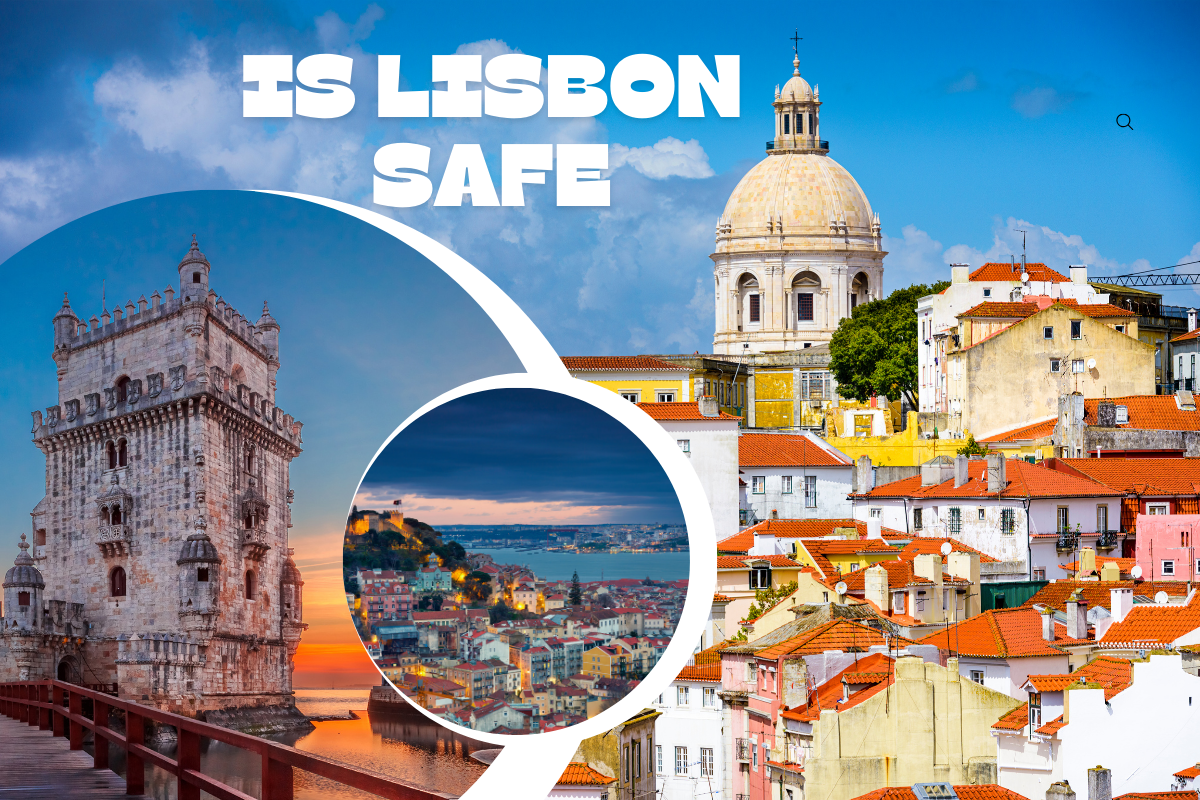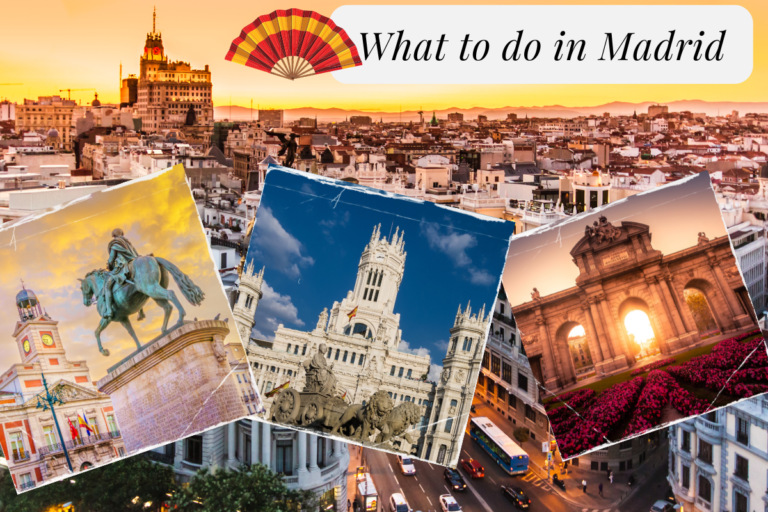Is Lisbon Safe for Travelers? All You Need to Know
Exploring new destinations is both thrilling and rewarding, but it can also raise concerns for travellers. The idea of venturing into unfamiliar territory, such as Lisbon, may feel daunting. You might find yourself wondering, “Is Lisbon safe?“
Choosing a destination renowned for its safety can transform your trip into a relaxing and enjoyable experience. Combining historical charm, vibrant culture, and a solid reputation for safety, Lisbon stands out as one of Europe’s most welcoming cities.
This article aims to provide an in-depth analysis of Lisbon’s safety, the perfect time to visit, crime rates, safest districts, places to avoid and tips for safe travel.
Perfect Time To Visit Lisbon
The ideal time to visit Lisbon is from March to May or September to October. During these months, the weather remains pleasantly warm, hotels are more affordable, and the city is less crowded compared to the summer.
Key Location
Lisbon, the charming capital of Portugal, is a city that combines history with modern life. It is located by the Atlantic coast and features beautiful architecture, from the detailed tilework on traditional buildings to impressive historic monuments.
Overview of Crime in Lisbon
Lisbon, like many other major cities, does have its share of crime. However, it is widely regarded as one of the safer capitals in Europe. The crime rate in Lisbon remains relatively low when compared to other major European cities.
According to the latest data, violent crimes such as murder, assault, and armed robbery are rare. The most common crimes in Lisbon are petty thefts, particularly pickpocketing, which often targets tourists in crowded areas.
What Makes Lisbon a Safe City
Portugal is known as one of the safest countries in the world, and this reputation includes its lively capital, Lisbon. Many things help make Lisbon a very safe city.
First, Portugal has low crime rates compared to many other countries. Violent crime is rare, and while petty crimes like pickpocketing happen, they aren’t very common. Lisbon, as the capital, shares in this safety, and most visitors find it a safe place to explore.
Portugal’s law enforcement is key to keeping the country safe. The police are well-trained and proactive, and in Lisbon, you’ll often see them in important areas, especially where tourists gather. Their presence helps prevent crime and makes both locals and visitors feel secure.
Top 3 Safest Cities in Portugal
Portugal is known for being a safe country, and some cities are especially secure. The top three safest cities are Lisbon, Porto, and Faro, each offering a mix of safety and good quality of life.
3. Faro
Faro is located in the Algarve region and is one of Portugal’s safest cities. It is known for its beautiful coast and nice weather, Faro has low crime rates, and its smaller size helps keep it safe. Faro’s peaceful atmosphere and friendly vibe make it a safe and welcoming place to visit or live.
2. Porto
Porto is Portugal’s second-largest city and is known for being safe. With charming streets, lively culture, and friendly people, Porto is secure for both locals and visitors. The city has low crime rates, and the police do a good job keeping it safe. Its smaller size creates a relaxed atmosphere, and the historic areas and safe public transportation make Porto a safe place to explore.
1. Lisbon
Lisbon is Portugal’s lively capital and is not only a political and economic hub but also one of the country’s safest cities. With a strong police presence, especially in tourist spots, and a low crime rate, Lisbon is very secure. The city’s focus on community policing and well-kept public spaces adds to its safety. Its reliable public transportation also makes it feel safe. Despite being a busy city, Lisbon is a welcoming and safe place to visit or live.
15 Safest districts in Lisbon
1. Chiado
Chiado is a lively and stylish area in central Lisbon. It has historic theatres, fancy shops, and famous cafes like A Brasileira. The architecture is a mix of classic and modern, making it a great spot for shopping and dining.
Best accommodation: Hotel do Chiado
Best Restaurant: Palácio Chiado
Main Attraction: The main attraction of Chiado is the Café A Brasileira. It is one of Lisbon’s most iconic cafes. You can visit this famous cafe for its rich history, elegant decor, and the statue of the renowned Portuguese poet Fernando Pessoa sitting outside.
2. Baixa
Baixa, or Downtown Lisbon, is the city’s main commercial and tourist area. It has big squares like Praça do Comércio and Rossio, with wide streets full of shops and cafes. The area is well-organized and is always lively.
Best Accommodaton: Vincci Baixa
Best Restaurant: Em Alta Na Baixa
Main Attraction: The main attraction of Baixa is the Praça do Comércio which is a grand square by the river with impressive architecture, including the Arco da Rua Augusta.
3. Alfama
Alfama is Lisbon’s oldest neighbourhood and is known for its narrow, winding streets and traditional Fado music. It has colourful houses and historic buildings, and you can enjoy great city views from landmarks like São Jorge Castle.
Best Accommodation: Pousada Alfama
Best Restaurant: Casa da Tia Helena
Main Attraction: The main attraction of Alfama is the São Jorge Castle (Castelo de São Jorge). This historic castle offers stunning panoramic views of Lisbon and is a key landmark in the area.
4. Príncipe Real
Príncipe Real is a trendy area popular with locals and expats. It features nice parks like Jardim do Príncipe Real and a mix of antique shops, organic markets, and cool restaurants. The neighbourhood also has lots of cultural events and a lively nightlife.
Best Accommodaton: Hotel Tivoli Avenida Liberdade Lisboa
Best Restaurant: Atalho Real
Main Attraction: The main attraction of Príncipe Real is the Jardim do Príncipe Real which is a beautiful park that features lush green spaces, playgrounds, and a weekly organic market.
5. Avenidas Novas
Avenidas Novas is a modern area with wide streets and new buildings. It’s a business hub with many offices and shopping centres like Atrium Saldanha. There are also parks and lots of dining options.
Best Accommodaton: Eurostars Lisboa Parque
Best Restaurant: LOCAL Avenida
Main Attraction: The main attraction of Avenidas Novas, a modern and upscale district in Lisbon, is the Gulbenkian Museum.
6. Parque das Nações
Parque das Nações is a modern area by the waterfront which was developed for the 1998 Expo. It has attractions like the Oceanarium and Vasco da Gama Tower, along with big parks. It’s family-friendly, with wide walkways, modern buildings, and lots of places to eat and shop.
Best Accommodaton: Martinhal Lisbon Oriente
Best Restaurant: Honest Greens Parque das Nações
Main Attraction: The main attraction of Parque das Nações is the Oceanário de Lisboa, one of the largest indoor aquariums in Europe.
7. Estrela
Estrela is a quiet residential area known for the beautiful Basilica da Estrela, a baroque church. It has Jardim da Estrela, a nice park with playgrounds and gardens.
Best Accommodation: The Emerald House Lisbon
Best Restaurant: Restaurante Medieval
Main Attraction: The main attraction of Estrela is the Basilica da Estrela, a stunning baroque church with impressive architecture and beautiful interior details.
8. Campo de Ourique
Campo de Ourique is a lively, family-friendly neighbourhood with a popular market, Mercado de Campo de Ourique, that sells fresh produce and gourmet foods. It has a mix of traditional and modern buildings and a friendly, active community.
Best Accommodaton: Hotel Vincci Liberdade
Best Restaurant: Amélia Lisboa
Main Attraction: The main attraction of Campo de Ourique is the Mercado de Campo de
9. Belém
Belém is a historic area with famous landmarks like the Jerónimos Monastery and Belém Tower. It’s known for its pastéis de nata from the Pastéis de Belém bakery. The area has beautiful river views and several important museums.
Best Accommodation: Four Seasons Ritz
Best Restaurant: Miolo
Main Attraction: The main attraction of Belém is the Jerónimos Monastery (Mosteiro dos Jerónimos.
10. Saldanha
Saldanha is a busy commercial area with modern buildings. It’s great for shopping and dining, featuring places like the Saldanha Residence and the Atrium Saldanha shopping centre. The area is well-connected and lively.
Best Accommodation: Lisbon Marriott Hotel
Best Restaurant: Blue Bistrot
Main Attraction: The main attraction of Saldanha is the Atrium Saldanha, a large shopping centre with a wide range of shops, dining options, and entertainment.
11. Amoreiras
Amoreiras is a high-end neighbourhood with luxury apartments and the Amoreiras Shopping Center. It has a mix of homes and businesses, and several embassies, and is known for its peaceful atmosphere, green spaces, and elegant buildings.
Best Accommodaton: Bairro Alto Hotel
Best Restaurant: Block House Amoreiras
Main Attraction: The main attraction of Amoreiras is the Amoreiras Shopping Center which is a large mall offering a variety of shops, restaurants, and entertainment options.
12. Lapa
Lapa is a quiet, wealthy neighbourhood with a mix of old and new buildings. It has embassies, elegant homes, calm streets, and lovely gardens. It’s a peaceful and stylish area popular with expats and diplomats.
Best Accommodation: Hotel York House Lisboa
Best Restaurant: Lapa Restaurant
Main Attraction: The main attraction of Lapa is the Basilica da Lapa, a beautiful church known for its grand architecture and serene atmosphere.
13. Restelo
Restelo is a calm, residential area near the Tagus River. It has luxurious homes and is close to embassies. The neighbourhood is peaceful, with well-kept streets and green spaces, making it a nice place to live.
Best Accommodaton: Altis Belém Hotel & Spa
Best Restaurant: ÚNICO – Restaurante Orgânico Lisboa, CCB
Main Attraction: The main attraction of Restelo is the Belém Tower (Torre de Belém), which is located nearby and offers historic significance and stunning views of the Tagus River.
14. Graça
Graça is a charming, historic neighbourhood with great viewpoints like Miradouro da Senhora do Monte. It has narrow streets, traditional houses, and lively markets and offers a taste of Lisbon’s history along with the beautiful city views.
Best Accommodaton: Valverde Lisboa Hotel & Garden
Best Restaurant: Via Graça
Main Attraction: The main attraction of Graça is the Miradouro da Senhora do Monte, a viewpoint offering one of the best panoramic views of Lisbon.
15. Alvalade
Alvalade is a residential area with both modern and traditional features. It’s family-friendly, with many shops, cafes, and green spaces. The neighbourhood is well-connected and has a strong sense of community.
Best Accommodation: VIP Grand Lisboa Hotel & Spa
Best Restaurant: MARGARITA Alvalade
Main Attraction: The main attraction of Alvalade is the Alvalade Market (Mercado de Alvalade), a bustling market offering fresh produce, local goods, and a variety of food options.
Common Crimes In Lisbon
Pickpocketing and Petty Theft
Pickpocketing is the most common crime in Lisbon, especially in tourist areas like the Baixa district, Alfama, and near attractions like the Belém Tower and Jerónimos Monastery.
Thieves often work in groups, using distractions to steal wallets, phones, and other valuables. However, the city’s police are alert, and there are regular patrols in places where this happens.
Violent Crime
Violent crime in Lisbon is rare. The city is usually safe for walking around, even at night. Mugging or assault is uncommon, especially in the central areas. However, as with any city, it’s important to stay aware of your surroundings and avoid isolated areas late at night.
Scams
In Lisbon, scams can take various forms, particularly targeting tourists who may be unfamiliar with the city. One common scam involves taxi drivers overcharging passengers by taking longer routes or adding unauthorised fees to the fare. Another scam is the “restaurant bill trick,” where some eateries may include extra items or inflate prices on the final bill, hoping tourists won’t notice.
Car Break-ins
Car break-ins are a concern in some parts of Lisbon, particularly in less crowded or poorly lit areas. Thieves typically target rental cars or vehicles parked in tourist hotspots, as they expect to find valuables like cameras, laptops, or bags left inside.
Drug Dealing
In Lisbon, drug dealing can be an issue, particularly in certain neighbourhoods or areas known for nightlife. Dealers might approach you or locals with offers to sell illegal substances, often in areas with high foot traffic like busy streets or near popular bars and clubs.
Personal Safety
Safety for Tourists
Tourists in Lisbon usually feel safe exploring the city. The locals are friendly and many speak English, which helps visitors get around and find assistance. Most tourist areas are well-lit and have a noticeable police presence. Still, we would advise you to stay alert in crowded places where pickpockets may be active.
Safety at Night
Lisbon is vibrant at night, especially in areas like Bairro Alto, which is famous for its nightlife. These areas are usually safe, but it’s best to stay on well-lit streets and avoid walking alone in unfamiliar places. Public transportation like trams and the metro is safe, but for safer travel taxis or rideshares are a good choice.
Safety for Solo Travelers
Lisbon is a safe destination for solo travellers, including solo female travellers. The city’s relaxed vibe and low crime rates add to the sense of security. There are , which is so safe. Still, solo travellers should follow basic precautions, like not showing valuables, staying aware of their surroundings, and letting someone know their plans, especially when exploring less crowded areas. For those who considering safety in various destinations, cancun is safest place to travel with family and for solo
Safety for Families
Families visiting Lisbon will find it a welcoming and safe place. With many parks, family-friendly attractions, and safe neighbourhoods, it’s a great spot for family trips. If you are a parent, keep an eye on your children in crowded areas to avoid pickpocketing or getting lost.
Transportation Safety
Public Transportation
Lisbon’s public transportation is generally safe and reliable. However, pickpocketing can be a problem on crowded trams and buses, especially on the popular Tram 28. Keeping an eye on your belongings and avoiding rush hours can help reduce risks.
Taxis and Rideshares
Taxis and rideshare services like Uber are widely available in Lisbon and are considered safe. Licensed taxis are easily identifiable by their black and green colours and should always have a meter running. It’s advisable to use official taxi ranks or reputable rideshare apps to avoid scams.
Health and Environmental Safety
Healthcare Facilities
Lisbon has a good healthcare system with many hospitals, clinics, and pharmacies. For emergencies, you can call 112. It’s a good idea to have travel insurance that covers medical costs, as private healthcare can be pricey. Pharmacies are common and provide over-the-counter meds, but it’s smart to bring any needed prescription medications with you.
Environmental Hazards
Lisbon has a mild climate, but summers can be hot, sometimes above 30°C (86°F). Stay hydrated, use sunscreen, and wear a hat for sun protection. The city is hilly, so be ready for a lot of walking and climbing, and wear comfortable shoes. Lisbon is not prone to major natural disasters, though it has had minor earthquakes in the past. The risk is low, and buildings are built to handle seismic activity.
Food and Water Safety
Lisbon has a rich food tradition and high food safety standards. Tap water is safe to drink, but some people prefer bottled water. Street food and local restaurants are generally safe.
Areas to Avoid
In Lisbon, most areas are safe, but some neighbourhoods may feel less secure, especially after dark. Here are a few places where you might want to be extra careful:
1. Intendente
Intendente is historically known for social issues and petty crime. It’s advisable to be cautious, especially at night, although recent efforts have improved the area.
2. Martim Moniz
It is a busy area with a high volume of tourists and locals, which can attract petty criminals. Be mindful of your belongings.
3. Cais do Sodr
While it has a vibrant nightlife, some parts can be less secure at night, with occasional incidents of petty crime.
4. Chelas
A neighbourhood where petty crime can be more common. It’s best to stay alert and avoid isolated areas, particularly in the evenings.
5. Areeiro
While Areeiro is generally safe, some parts may experience petty crime, especially around the train station area.
6. Amadora
Tourists might want to avoid Amadora because it has higher crime rates than central Lisbon and can feel less safe. It’s a crowded area with more urban issues and not many attractions.
7. Casal Ventoso
Tourists might want to avoid Casal Ventoso due to its social issues and poverty, which can affect safety. The area doesn’t have many attractions or amenities for visitors and may not offer the same enjoyable experience as more developed parts of Lisbon.
Level of Crimes in Lisbon
| Level of crime | 25.69 | Low |
| Increase in Crime | 52.99 | Moderate |
| Concerns About Home Break-ins and Theft | 22.66 | Low |
| Concerns About Being Mugged or Robbed | 30.67 | Low |
| Concerns About Car Theft | 22.67 | Low |
| Concerns About Theft from Cars | 35.35 | Low |
| Concerns About Being Attacked | 24.27 | Low |
| Concerns About Being Insulted | 24.95 | Low |
| Concerns About Discrimination-Based Physical Attacks | 15.75 | Very Low |
| Problems with Drug Use and Dealing | 41.68 | Moderate |
| Problems with Property Crimes | 36.14 | Low |
| Problems with Violent Crimes | 23.39 | Low |
| Problems with Corruption and Bribery | 54.79 | Moderate |
Safety Level in Lisbon
These insights are drawn from the experiences of visitors over the past five years.
Tips for Staying Safe in Lisbon
General Safety Tips
- Keep Valuables Secure: Use a money belt or cross-body bag to keep your valuables close. Avoid carrying large sums of cash.
- Stay Aware of Your Surroundings: Especially in crowded areas, be mindful of your belongings and stay vigilant for any suspicious activity.
- Avoid Isolated Areas at Night: Stick to well-lit, populated areas if you’re out after dark.
- Use Reputable Transportation: Whether it’s a taxi, rideshare, or public transport, use official services to avoid scams.
- Know Emergency Numbers: The European emergency number is 112, which can be dialled for police, fire, or medical emergencies.
Safety for Women Travelers
- Stay in Well-Lit Areas: If travelling alone at night, stick to busy streets and avoid shortcuts through alleys or parks.
- Trust Your Instincts: If something feels off, trust your instincts and remove yourself from the situation.
Safety for Families with Children
- Keep Children Close: In crowded areas, hold your children’s hands or keep them within sight to prevent them from getting lost.
- Use Child-Friendly Transportation: Consider using taxis or rideshares for convenience when travelling with young children.
Vaccination and Health Precautions
If you’re travelling to Lisbon, it’s advisable to be fully vaccinated before your trip.
Final Thoughts
Overall, Lisbon is a safe and friendly city for both tourists and residents. It’s a good idea to stay aware of your surroundings and take basic precautions, but serious crime is rare.
Whether you’re exploring historic neighbourhoods, enjoying the nightlife, or relaxing on the beach, you can feel confident that Lisbon cares about your safety.
With its welcoming locals, rich culture, and low crime rates, Lisbon is one of Europe’s most attractive and secure travel destinations.
FAQs
1. Is it safe to go out at night in Lisbon?
- Yes, it is generally safe to go out at night in Lisbon, especially in well-populated areas like the city centre and popular neighbourhoods. However, it’s advisable to stay aware of your surroundings and avoid isolated areas.
2. Are there areas to avoid in Lisbon?
- While Lisbon is generally safe, there are a few areas where extra caution is advised, especially at night. Neighbourhoods like Intendente, Martim Moniz, and parts of Cais do Sodré can be more prone to petty crime or feel less secure after dark. It’s best to stick to well-lit, populated areas and avoid isolated streets in these neighbourhoods.
3. How safe is Lisbon for solo female travellers?
- Lisbon is considered quite safe for solo female travellers. The city is friendly, with low crime rates and a welcoming atmosphere. However, as with any destination, it’s wise to stay vigilant. Avoid isolated areas at night, keep an eye on your belongings in crowded places, and use reputable transportation options. Most solo female travellers find Lisbon to be a pleasant and secure place to explore.
4. Is Lisbon safe for families?
- Yes, Lisbon is generally safe for families.







